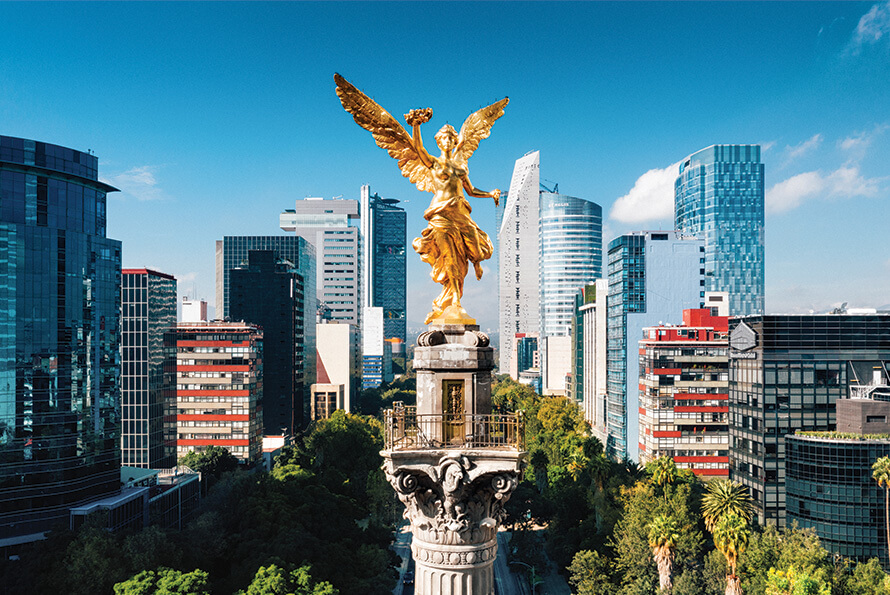




Currently, Mexico is an extremely attractive territory for the relocation of production chains, thanks to its proximity to the United States. Due to the economic effects of the pandemic, international geopolitical conflicts and the scarcity of resources, companies have begun to rethink their operation logistics, specifically through the cost-effective approach of nearshoring.1
Nearshoring is the practice of transferring a business operation to a nearby country, especially in preference to a more distant one. US brands who are embracing nearshoring strategy can reap the benefits of outsourcing to a nearby country like Mexico, including shortened supply chains and reduced time-to-market. Because of this, brands can expedite their marketing campaigns and create new efficiencies.
Mexico is the 16th largest market for e-commerce with a total revenue of $23.2 billion generated in 2021. With a year-over-year (YoY) increase of 18%, the Mexican e-commerce market contributed to the worldwide growth rate of 15% in 2021.2
Due to Mexico’s prominent e-commerce market, this Latin American (LATAM) region is a great opportunity for brands—especially brands located in the US—looking to expand their affiliate programs into LATAM.
In 2020, the population of Mexico was over 126 million. Around +20 million people are concentrated in Mexico City and its metropolitan area, followed by Guadalajara (+4.7M), and Monterrey (+4.2M).3
Within the Mexican market, most industries grew during 2021, although not all of them recovered their pre-pandemic levels. Among those that stand out for their increase in GDP, is tourism (+29.1%), followed by consumption, with an annual advance of 10.3% driven by online sales.4
Mexico is one of the main e-commerce markets in LATAM. In 2020, more than 39% of the Mexican population acquired goods or services online. Projections suggest this will grow to 58% by 2025.5
By the end of 2021, the percentage of Mexican internet users increased 4.1% to 88.6M, which represents 75.6% of the country’s population.6
One common challenge many affiliate programs face when trying to expand into Mexico are locally-based affiliates being unfamiliar with working strictly on a Cost Per Action (CPA) model. However, brands can still leverage successful affiliate marketing programs in Mexico by building hybrid models that combine CPA with other models, such as CPL, CPC and flat fee.
In Mexico, the predominant type of affiliate partners are content partners. These partners can provide brand awareness and engagement, but usually have a low conversion rate. Programs looking to establish themselves in Mexico should take this into consideration and build an effective strategy with this in mind.
In addition to a high number of content affiliates, there are also several sub-affiliate networks operating successfully in Mexico. Sub-affiliate networks can scale programs quickly and provide access to partners that are familiar with affiliate marketing. These networks are especially vital to brands new to this region and needing help expanding their local affiliate base.
Cashback (mainly banks) and coupon sectors are also experiencing strong development and expansion in Mexico. Although cashback partners (also known as loyalty partners) are still behind compared to other regions—such as Brazil—some Mexican-based affiliate partners are shifting toward cashback as a rewards model. Along with partners, brands are also looking for strategic cashback affiliates that use rewards to help them retain customers during an uncertain economy.
Another partner type gaining popularity in Mexico is influencer marketing. Millennials and Gen Z audiences are interested in authenticity and will seek insights from people whose lives are similar to theirs or what they aspire their lives to be. Peer-to-peer marketing is becoming an important tool for brands in particular, with niche micro-influencers becoming most successful as brand ambassadors, since they command greater loyalty from their fans in comparison to larger celebrities and/or companies.
Micro-influencers can also be easier to collaborate with, in terms of cost models, rates, co-creation of content, repurposing of content assets, and more. Because of their fan loyalty, they tend to have a higher conversion volume than some macro-influencers—as long as it’s the right partnership fit.
Some top-performing affiliates/networks located in Mexico are:
Business professionals in Mexico pay attention to hierarchy within business settings; senior figures typically like to be acknowledged, respected and to an extent flattered. This hierarchy should be accounted for when doing business with locally-based affiliates.
Status consciousness and personal relationships also play an important role in influencing and impacting business culture, therefore taking a minute for pleasantries before and after a meeting can make a significant difference in the outcomes of an affiliate marketing program.
While emails are used for written communication, people in Mexico often use WhatsApp for messaging and Skype, Google Meet, and/or Zoom for conference calls.
In terms of the preferred communication style, making some sort of connection with the partner or client to build up a reputation and to promote trust is key. Mexicans are usually polite, warm and upbeat, and on the flip side there is a cultural tendency to avoid conflict, making getting honest and straightforward feedback sometimes difficult.
Note: Some of the above may shift slightly each year.
As affiliate marketing grows across the LATAM region, Mexico continues to offer excellent opportunities for brands looking to expand their affiliate programs.
References
1 https://www2.deloitte.com/mx/es/pages/dnoticias/articles/nearshoring-en-mexico.html
2 https://ecommercedb.com/en/markets/mx/all
3 https://cuentame.inegi.org.mx/poblacion/habitantes.aspx?tema=P
4 https://www2.deloitte.com/mx/es/pages/finance/articles/tendencias-de-industrias-abril-2022.html
5 https://es.statista.com/previsiones/703404/tasa-penetracion-comercio-electronico-mexico
6 https://www.bnamericas.com/es/reportajes/radiografia-del-uso-de-internet-en-mexico#:~:text=En%20general%2C%20hab%C3%ADa%2024%2C3,nacional%2C%20al%20cierre%20de%202021